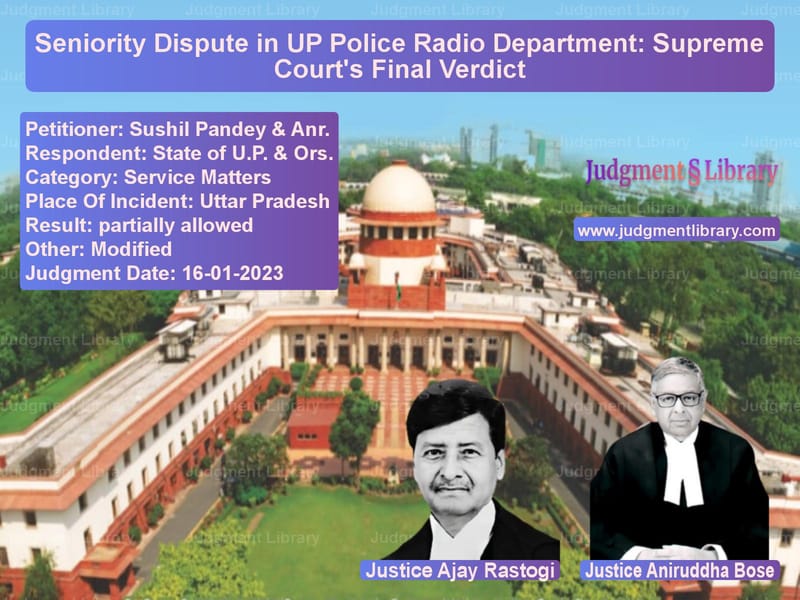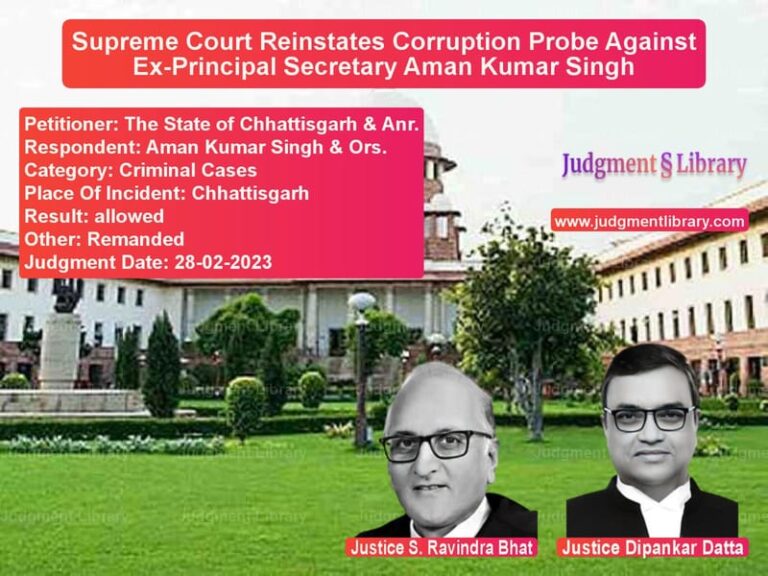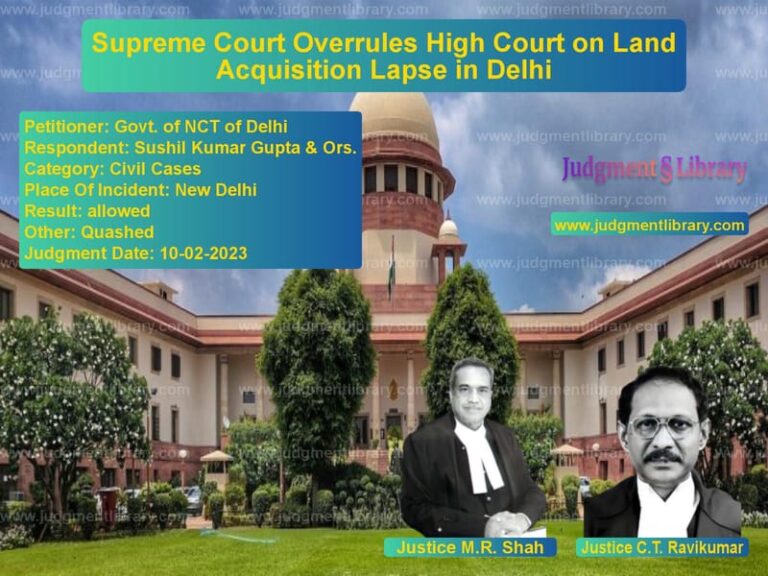Seniority Dispute in UP Police Radio Department: Supreme Court’s Final Verdict
The case of Sushil Pandey & Anr. v. State of U.P. & Ors. revolves around the legality of a selection list for the posts of Assistant Radio Officers in the Uttar Pradesh Police Radio Department. The Supreme Court was called upon to adjudicate on disputes over seniority between direct recruits and promotees, a matter that had been litigated for nearly three decades.
Background of the Case
The dispute originated in 1998 when the Uttar Pradesh Police Radio Service Rules, 1979 (“1979 Rules”) mandated that vacancies for Assistant Radio Officers be filled 50% through direct recruitment and 50% through promotion from the feeder cadre of Radio Inspectors. Over the years, discrepancies in recruitment and seniority determination led to multiple rounds of litigation.
The primary grievance was that the selection list of October 25, 2013, allegedly violated previous court directives. The appellants, who were promotees, argued that their seniority was unfairly disturbed in favor of direct recruits.
Legal Issues Considered
The Supreme Court examined several key issues:
- Whether the selection and seniority lists complied with the 1979 Rules.
- Whether Rule 17 (regarding combined selection lists) and Rule 22 (seniority determination) were correctly followed.
- Whether the High Court’s earlier rulings had been properly implemented.
- Whether promotees should be considered senior based on their earlier entry into service.
- Whether vacancies arising from the death or superannuation of officers should be reallocated or filled afresh.
Arguments by the Appellants (Promotees)
The promotees, led by the appellants, argued that:
- The direct recruits were given seniority without considering the actual date of vacancy.
- The promotees had been working in the cadre for years before direct recruits joined, and hence, should be considered senior.
- The High Court’s previous ruling of September 12, 2012, was not followed while preparing the 2013 list.
- As per Rule 22, seniority should be determined from the date of entry into service.
- The names of superannuated and deceased officers should not have been included in the selection list.
Arguments by the Respondents
The respondents, including the State of Uttar Pradesh, contended that:
- The seniority list was prepared in accordance with the High Court’s previous directives.
- Appointments were made under a combined selection process, so seniority had to be determined as per Rule 17.
- The selection list maintained the prescribed quota and rota system.
- The inclusion of deceased and superannuated officers was in accordance with previous rulings.
Supreme Court’s Judgment
The Supreme Court ruled as follows:
- Combined selection was correctly applied: The Court noted that the combined selection process followed the High Court’s 2012 ruling.
- Seniority must be determined from a common appointment date: The Court directed that all officers in the 2013 list be considered to have entered service on January 30, 1996, to ensure fairness.
- Intra-stream seniority rules must be followed: While the common entry date was fixed, seniority within each stream (direct recruits and promotees) would be determined as per Rule 22.
- Vacancies arising from superannuated or deceased officers should be filled afresh: The Court ruled that such vacancies should not be automatically filled by pushing up lower-ranked officers.
- No retrospective seniority: The Court reaffirmed that no officer can claim seniority from a date before their actual appointment.
- Career benefits already granted will not be disturbed: The Court ensured that those who had received promotions based on the previous list would not face demotions or loss of benefits.
Analysis of the Judgment
The Supreme Court’s ruling balances the rights of both direct recruits and promotees. It ensures that promotees are not unfairly placed below direct recruits while maintaining compliance with established rules.
Implications for Promotees
- They retain their rightful seniority, subject to the fixed appointment date.
- They cannot claim seniority over direct recruits if they entered service later.
Implications for Direct Recruits
- They are given seniority only from their actual appointment date.
- The selection process is upheld as fair and legally valid.
Implications for Future Recruitment
- Vacancies due to retirement or death must be filled afresh instead of adjusting existing officers.
- Selection lists must strictly follow quota and rota rules.
Conclusion
The Supreme Court’s ruling provides finality to a long-standing dispute. By ensuring a uniform entry date and adherence to seniority rules, it upholds fairness while maintaining administrative efficiency. This case serves as a crucial precedent for resolving similar seniority disputes in government service.
Petitioner Name: Sushil Pandey & Anr..Respondent Name: State of U.P. & Ors..Judgment By: Justice Ajay Rastogi, Justice Aniruddha Bose.Place Of Incident: Uttar Pradesh.Judgment Date: 16-01-2023.
Don’t miss out on the full details! Download the complete judgment in PDF format below and gain valuable insights instantly!
Download Judgment: sushil-pandey-&-anr.-vs-state-of-u.p.-&-ors.-supreme-court-of-india-judgment-dated-16-01-2023.pdf
Directly Download Judgment: Directly download this Judgment
See all petitions in Promotion Cases
See all petitions in Recruitment Policies
See all petitions in Public Sector Employees
See all petitions in Judgment by Ajay Rastogi
See all petitions in Judgment by Aniruddha Bose
See all petitions in partially allowed
See all petitions in Modified
See all petitions in supreme court of India judgments January 2023
See all petitions in 2023 judgments
See all posts in Service Matters Category
See all allowed petitions in Service Matters Category
See all Dismissed petitions in Service Matters Category
See all partially allowed petitions in Service Matters Category







